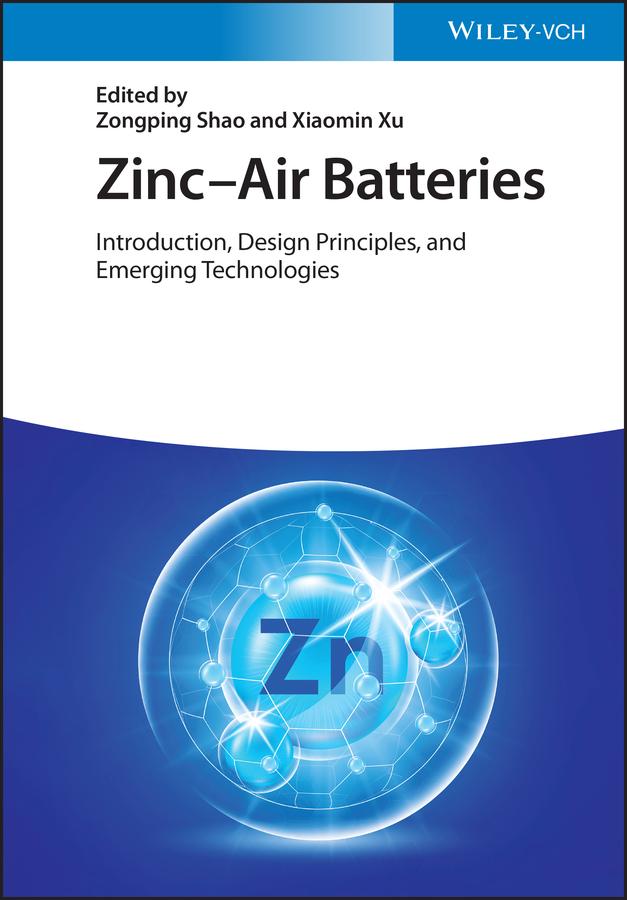
Sofort lieferbar (Download)
Zinc-Air Batteries
Authoritative and comprehensive resource covering foundational knowledge of zinc-air batteries as well as their practical applications
Zinc-Air Batteries provides a comprehensive understanding of the history and development of Zn-air batteries, with a systematic overview of components, design, and device innovation, along with recent advances in the field, especially with regards to the cathode catalyst design made by cutting-edge materials, engineering processes, and technologies.
In particular, design principles regarding the key components of Zn-air batteries, ranging from air cathode, to zinc anode, and to electrolyte, are emphasized. Furthermore, industrial developments of Zn-air batteries are discussed and emerging new designs of Zn-air batteries are also introduced. The authors argue that designing advanced Zn-air battery technologies is important to the realization of efficient energy storage and conversion-and, going further, eventually holds the key to a sustainable energy future and a carbon-neutral goal.
Edited and contributed to by leading professionals and researchers in the field, Zinc-Air Batteries also contains information regarding:
- Design of oxygen reduction catalysts in primary zinc-air batteries, including precious metals, single-atoms, carbons, and transition metal oxides
- Design of bifunctional oxygen catalysts in rechargeable zinc-air batteries, covering specific oxygen redox reactions and catalyst candidates
- Design of three-dimensional air cathode in zinc-air batteries, covering loading of carbon-based and transition metal catalysts, plus design of the three-phase interface
- Design of electrolyte for zinc-air batteries, including liquid electrolytes (e. g. , alkaline) and gel polymer electrolytes (e. g. , PVA hydrogel)
For students, researchers, and instructors working in battery technologies, materials science, and electrochemistry, and for industry and government representatives for decision making associated with energy and transportation, Zinc-Air Batteries summarizes the research results on Zn-air batteries and thereby helps researchers and developers to implement the technology in practice.
Inhaltsverzeichnis
1 INTRODUCTION TO ZINC-AIR BATTERIES
1. 1 Introduction
1. 2 History of Zn-air battery
1. 3 Structure and principle of Zn-air battery
1. 4 Evaluation of Zn-air battery
1. 5 Main issues of Zn-air battery
2 DESIGN OF OXYGEN REDUCTION CATALYSTS IN PRIMARY ZINC-AIR BATTERIES
2. 1 Overview of oxygen reduction catalysts
2. 2 Precious metal catalysts
2. 3 Single-atom catalysts
2. 4 Carbon-based catalysts
2. 5 Transition metal oxide catalysts
2. 6 Miscellaneous catalysts
3 DESIGN OF BIFUNCTIONAL OXYGEN CATALYSTS IN RECHARGEABLE ZINC-AIR BATTERIES
3. 1 Oxygen redox reactions and catalyst candidates
3. 2 Carbon
3. 3 Metal oxides
3. 4 Heterostructured catalysts
3. 5 Carbon-based composites
3. 6 Other emerging catalysts
3. 7 Binder-free catalysts
4 DESIGN OF THREE-DIMENSIONAL AIR CATHODE IN ZINC-AIR BATTERIES
4. 1 Overview of three-dimensional air cathode
4. 2 Load of carbon-based catalysts
4. 3 Load of transition metal compounds
4. 4 Design of three-phase interface
4. 5 Conclusions
5 DESIGN OF ZN ANODE FOR ZINC-AIR BATTERIES
5. 1 Introduction
5. 2 Methods to optimize Zn anode for Zn-air batteries
5. 3 Conclusion and perspectives
6 DESIGN of ELECTROLYTE FOR ZINC-AIR BATTERIES
6. 1 Liquid electrolytes
6. 2 Gel polymer electrolyte
7 NEW DESIGN of ZINC-AIR BATTERIES
7. 1 Flexible Zn-air battery
7. 2 Hybrid Zn-air battery
7. 3 Zn-air flow battery
8 INDUSTRIAL DEVELOPMENTS OF ZN-AIR BATTERIES
8. 1 History of Zn-air batteries
8. 2 Primary Zn-air batteries
8. 3 Rechargeable Zn-air batteries
1. 1 Introduction
1. 2 History of Zn-air battery
1. 3 Structure and principle of Zn-air battery
1. 4 Evaluation of Zn-air battery
1. 5 Main issues of Zn-air battery
2 DESIGN OF OXYGEN REDUCTION CATALYSTS IN PRIMARY ZINC-AIR BATTERIES
2. 1 Overview of oxygen reduction catalysts
2. 2 Precious metal catalysts
2. 3 Single-atom catalysts
2. 4 Carbon-based catalysts
2. 5 Transition metal oxide catalysts
2. 6 Miscellaneous catalysts
3 DESIGN OF BIFUNCTIONAL OXYGEN CATALYSTS IN RECHARGEABLE ZINC-AIR BATTERIES
3. 1 Oxygen redox reactions and catalyst candidates
3. 2 Carbon
3. 3 Metal oxides
3. 4 Heterostructured catalysts
3. 5 Carbon-based composites
3. 6 Other emerging catalysts
3. 7 Binder-free catalysts
4 DESIGN OF THREE-DIMENSIONAL AIR CATHODE IN ZINC-AIR BATTERIES
4. 1 Overview of three-dimensional air cathode
4. 2 Load of carbon-based catalysts
4. 3 Load of transition metal compounds
4. 4 Design of three-phase interface
4. 5 Conclusions
5 DESIGN OF ZN ANODE FOR ZINC-AIR BATTERIES
5. 1 Introduction
5. 2 Methods to optimize Zn anode for Zn-air batteries
5. 3 Conclusion and perspectives
6 DESIGN of ELECTROLYTE FOR ZINC-AIR BATTERIES
6. 1 Liquid electrolytes
6. 2 Gel polymer electrolyte
7 NEW DESIGN of ZINC-AIR BATTERIES
7. 1 Flexible Zn-air battery
7. 2 Hybrid Zn-air battery
7. 3 Zn-air flow battery
8 INDUSTRIAL DEVELOPMENTS OF ZN-AIR BATTERIES
8. 1 History of Zn-air batteries
8. 2 Primary Zn-air batteries
8. 3 Rechargeable Zn-air batteries
Produktdetails
Erscheinungsdatum
26. Oktober 2022
Sprache
englisch
Auflage
1. Auflage
Seitenanzahl
304
Dateigröße
83,93 MB
Herausgegeben von
Zongping Shao, Xiaomin Xu
Verlag/Hersteller
Kopierschutz
mit Adobe-DRM-Kopierschutz
Produktart
EBOOK
Dateiformat
EPUB
ISBN
9783527837922
Entdecken Sie mehr
Bewertungen
0 Bewertungen
Es wurden noch keine Bewertungen abgegeben. Schreiben Sie die erste Bewertung zu "Zinc-Air Batteries" und helfen Sie damit anderen bei der Kaufentscheidung.









